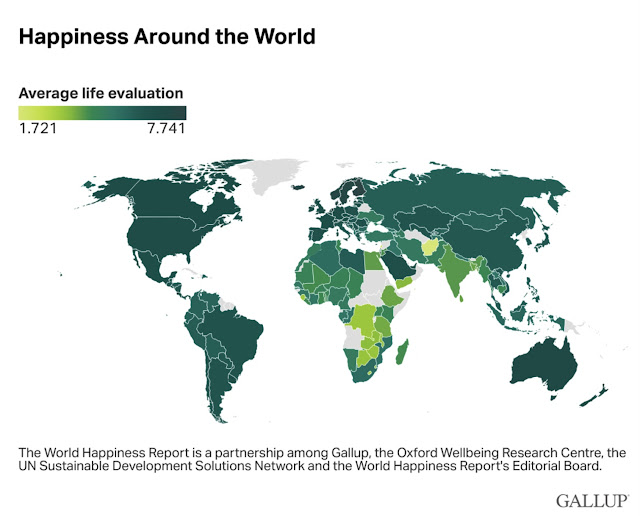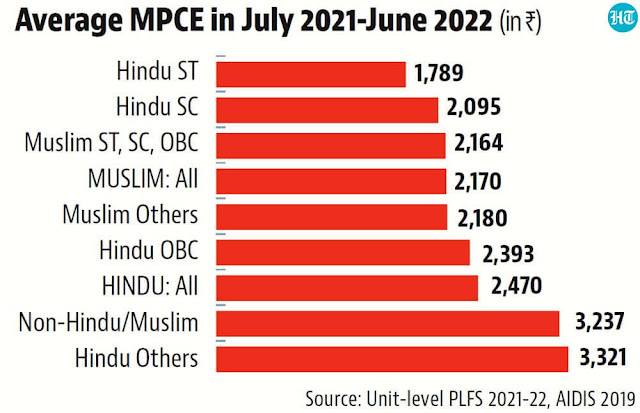
Agriculture, Caste, Religion and Happiness in South Asia
By Riaz Haq
CA

Pakistan's agriculture sector GDP grew at a rate of 5.2% in the October-December 2023 quarter, according to the government figures. This is a rare bright spot in the overall national economy that showed just 1% growth during the quarter. The strong performance of the farm sector gives a much-needed boost to about 37% of Pakistan's workforce engaged in agriculture. It helps the country's rural economy improve its living standards. In the same period, India's agriculture sector which employs 43% of the workforce slowed to 1.2% growth . This could be one possible contributing factor for Pakistan (rank 108) significantly outperforming India (rank 126) on the World Happiness Index once again.

|
World Happiness Map 2023. Source: Gallup |
Pakistan has seen bumper crops of rice, corn, wheat, sugar, and cotton this fiscal year after the devastation caused by massive floods in the prior year. During the first six months of fiscal year 2023-24, exports of agro and food products from Pakistan have soared by 64% as compared to the same period during 2022-2023. In December alone, there was a growth of 118%, as $882 million of food was exported as compared to $404 million in the same month in 2022-23. Pakistan's gains in the food export market have come at a time when India has had to limit or ban exports of rice, corn, sugar, and other commodities due to crop failures.
The World Happiness Report attributes India's poor ranking in the Index to widespread caste discrimination in the country. Older Indians belonging to upper castes, and “never experience[d] discrimination or ill-treatment” were “more satisfied with their lives”, according to the report.
Caste discrimination contributed “significantly to the caste-based discrepancies in life satisfaction”, the research showed. Caste backgrounds determined access to education, social services, health care, or financial security in India. Individuals with secondary or higher education and those of higher social castes reported higher life satisfaction than those without access to formal education and those from Scheduled Castes (SC) and Scheduled Tribes (ST).
Another factor contributing to India's unhappiness is the ruling party's targeting of its minorities, including Christians, Muslims, and Sikhs. Here's an excerpts from Rohit Khanna's piece in The Quint describing this issue:
"In recent years, 20 percent of India, our minorities, have been targeted – economically, socially, and physically. We have all seen multiple viral videos calling for the economic boycott of Muslims, of them being mob-lynched on the roads, of their homes being bulldozed, of inter-faith marriages being targeted as ‘love-jihad’ and more. We have seen videos of Christian pastors and congregations being roughed up and of church buildings being vandalized. We have seen protesting Sikh farmers being vilified on communal lines as ‘Khalistanis’".
The average MPCE (Monthly Per Capita Consumption Expenditure) for Indian Muslims is only Rs 2,170. The average MPCE for upper caste Hindus is Rs. 3,321, the highest of all groups. Lower-caste Hindus fare much worse than upper-caste Hindus, according to Indian government data .

|
Average monthly per capita consumption expenditure by caste in India - Source: Hindustan Times
|
India is almost totally dominated by the upper caste Hindus. It is not just the 220 million Dalits (untouchables), or the 190 million Muslims , or the 110 million from “scheduled tribes” (Adivasis) who are under-represented in positions of power and privilege, but also the 40-50% of Hindus who come from the widest tier of the pyramid, the Shudras or laboring castes, known as Other Backwards Classes (OBCs), according to a report in The Economist Magazine.
Some Indians claim without evidence that Indian Muslims are richer than Pakistani Muslims. The fact is that the average monthly per capita expenditure (MPCE) in Pakistan was PKR 5,959 in 2019-20, the year closest to 2021-22 for which the Indian MPCE data is available. Using the 2019 average exchange rate of 2.136 PKR to INR, this works out to MPCE of INR 2,789 in Pakistan, higher than for Indian Hindus (INR 2,470) and Muslims (INR 2,170). As to the cost of living in the two countries, Pakistan is 15.8% cheaper than India without rent and 20.1% cheaper with rent, according to Numbeo .
While it is true the Pakistani currency has suffered significant devaluation in the last couple of years, there have been large increases in wages . Pakistan's minimum wage has increased 14 times since 2001, from 14% to 67%. The minimum wage for unskilled workers in 2023 is 32,000 Pakistani rupees per month, up from 25,000 rupees in 2022. The cost of living has been a key factor in determining the new rate.

|
Income poverty in Bangladesh, India, and Pakistan - Source Our World in Data |
Over 75% of the world's poor deprived of basic living standards (nutrition, cooking fuel, sanitation, and housing) live in India compared to 4.6% in Bangladesh and 4.1% in Pakistan, according to a recently released OPHI/UNDP report on multidimensional poverty. Here's what the report says: "More than 45.5 million poor people are deprived in only these four indicators (nutrition, cooking fuel, sanitation, and housing). Of those people, 34.4 million live in India, 2.1 million in Bangladesh and 1.9 million in Pakistan—making this a predominantly South Asian profile".

